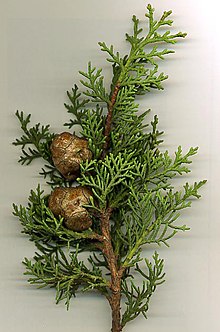
Back Cupressus sempervirens AN سرو المتوسط Arabic سرو المتوسط ARZ Cupressus sempervirens AST Həmişəyaşıl sərv Azerbaijani Кіпарыс вечназялёны Byelorussian Обикновен кипарис Bulgarian Xiprer Catalan Cupressus sempervirens CEB Cypřiš stálezelený Czech
This article may require copy editing for grammar, style, cohesion, tone, or spelling. (October 2023) |
| Mediterranean cypress | |
|---|---|

| |
| Mediterranean Cypress foliage and cones | |
| Scientific classification | |
| Kingdom: | Plantae |
| Clade: | Tracheophytes |
| Clade: | Gymnospermae |
| Division: | Pinophyta |
| Class: | Pinopsida |
| Order: | Cupressales |
| Family: | Cupressaceae |
| Genus: | Cupressus |
| Species: | C. sempervirens
|
| Binomial name | |
| Cupressus sempervirens | |

| |
| Green: probable natural range in the Mediterranean Basin Orange: range including human introductions Red (small areas): Residual natural stands | |
Cupressus sempervirens, the Mediterranean cypress (also known as Italian cypress,[1] Tuscan cypress, Persian cypress, or pencil pine), is a species of cypress native to the eastern Mediterranean region and Iran. Cupressus sempervirens is a seeded vascular plant. As a seeded plant, it uses seeds to reproduce.[2] While some studies show it has modern medicinal properties, it is most noted for uses in folk medicine, where the dried leaves of the plant are used for a variety of ailments.[3] It is well adapted to the conditions and the environment that it lives in due to the ability to survive in both acidic and alkaline soils, and withstand drought.[4] Cupressus sempervirens is widely present in culture, most notably in Iran, where it is both a sacred tree and is a metaphor for "the graceful figure of the beloved".[5]
- ^ BSBI List 2007 (xls). Botanical Society of Britain and Ireland. Archived from the original (xls) on 2015-06-26. Retrieved 2014-10-17.
- ^ "Cupressus sempervirens (Mediterranean cypress) description". www.conifers.org. Retrieved 2023-10-17.
- ^ Selim, Samy A; Adam, Mohammed E; Hassan, Sherif M; Albalawi, Abdulrhman R (December 2014). "Chemical composition, antimicrobial and antibiofilm activity of the essential oil and methanol extract of the Mediterranean cypress (Cupressus sempervirens L.)". BMC Complementary and Alternative Medicine. 14 (1): 179. doi:10.1186/1472-6882-14-179. ISSN 1472-6882. PMC 4052795. PMID 24890383.
- ^ "Supporting EFSA assessment of the EU environmental suitability for exotic forestry pests: Final Report". EFSA Supporting Publications. 11 (3). March 2014. doi:10.2903/sp.efsa.2014.en-434. ISSN 2397-8325.
- ^ Aʿlam, Hūšang (2020-08-30), "CYPRESS", Encyclopaedia Iranica Online, Brill, retrieved 2023-10-30
